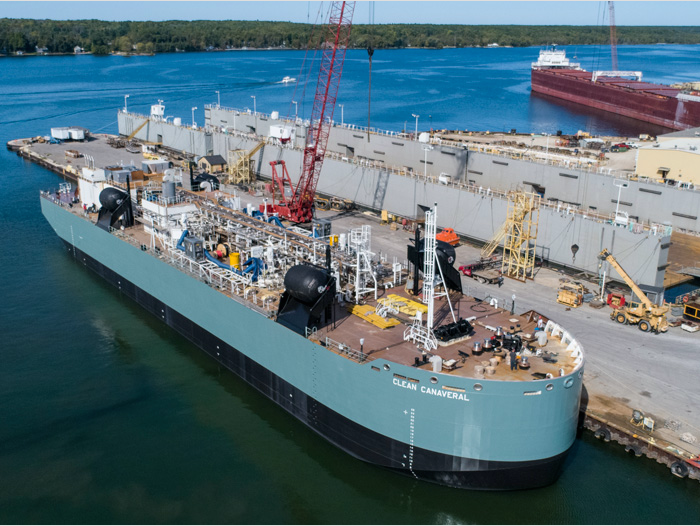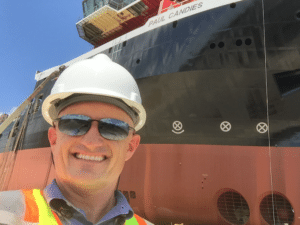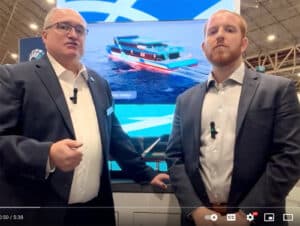
Q&A: 10 Minutes with Fincantieri Bay Shipbuilding
Written by Heather Ervin
Clean Canaveral at Fincantieri Bay Shipbuilding (Credit: Fincantieri Bay Shipbuilding)
In a ceremony held December 3, 2021, Sturgeon Bay, Wis., shipbuilder Fincantieri Bay Shipbuilding delivered the 340 foot long, 5,500-cubic-meter LNG bunkering barge, Clean Canaveral, to Polaris New Energy. The vessel, which is also our Vessel of the Month in this issue (see page 10), is the largest ATB bunkering barge thus far built in the U.S. and will soon be followed by a second of similar size, on order at the shipyard for a Polaris New Energy affiliate.
Fincantieri Bay Shipbuilding is a full-service shipyard, specializing in new construction, repair, conversion and sustainment of commercial vessels. The company’s portfolio includes articulated tug barge (ATB) units, barges, dredges, ferries, platform support vessels, and specialty vessels including self-unloading carriers.
This year, Fincantieri Bay Shipbuilding says it will be delivering the Mark Barker, the first U.S.-flagged self-unloading vessel for Great Lakes service built since the 1980s.
The new ship being built specifically for the Great Lakes is part of a company legacy of shipbuilding in the region. Fincantieri Bay Shipbuilding has been upgrading and building ships for the Great Lakes for generations.
In a story we ran in September, the shipyard told us that the Michigan Trader, as well as the Mark Barker, represent a significant lineage of our company.
With Fincantieri Marine Group member Marinette Marine Corporation recently awarded a $38 million contract for design and construction of a Constellation-class frigate, the shipbuilder is improving its infrastructure to meet the challenge of the project. Fincantieri currently is investing $300 million in its Wisconsin shipyards.
But that’s not all the shipyard has been up to lately. Justin Slater, director of sales and marketing at Fincantieri Bay Shipbuilding gave us the scoop.
Marine Log (ML): Last year, VanEnkevort Tug & Barge took delivery of the Michigan Trader, a self-unloading barge, built by your shipyard. Can you tell us more about this barge and whether you have similar projects planned for 2022 or the near future?
Justin Slater (JS): Fincantieri Bay Shipbuilding was fortunate to win this project. The trade on the Great Lakes is fairly stable thus not prone to spikes in demand. VanEnkevort Tug & Bargehas been a long time customer of the shipyard so they were very comfortable trusting us with this important project.
First of all, the ATB Barge is 740 feet in length. When most hear that this is a “barge,” they envision something much smaller. The barge also has a 78-foot beam and a 30-foot draft. The unloading boom is a hefty 265 feet in length and has a capacity up to 37,000 LT of cargo.
The choice for the 78-foot beam allows flexibility to trade into the Saint Lawrence Seaway; however, the vessel’s initial trade will be in the Great Lakes.
Regarding similar projects, Fincantieri Bay is currently building the Mark Barker for Interlake Steamship, the first U.S. Flagged Great Lakes self-unloading ship that has been built since the early ‘80s. While the shipyard has yet to see huge demand in this market for new construction opportunities, we expect that other owners are evaluating their options to manage the aging Great Lakes fleet.
ML: The shipyard specializes in new construction, repair and conversion projects for the most part. This includes ATBs, barges, dredges, ferries and so on. What would you say are your top requested newbuild vessels?
JS: The most active markets at the present time are the LNG bunkering barges, wind farm SOVs and dredges. There is also some lesser activity on the ferry front.
ML: The weather in the Great Lakes can be bitterly cold, icy and windy. Are there special precautions the shipyard takes during those winter months to keep business moving? What other hurdles are there to shipbuilding that the yard has found solutions to?
JS: Yes, we experience winter, but weather is relative and our workforce and facilities are prepared for our way of life. While we do occasionally get very cold days that slow us down, the shipyard has never shut down for winter weather.
Additionally, the majority of the shipyard activity is accomplished in climate-controlled buildings, which ensures schedule adherence. The shipyard also has the necessary heavy equipment for winter tasks such as snow removal, etc.
Also, the water around the shipyard freezes. We manage that by strategically placing bubblers around the ships, which prevents them from getting frozen. This allows our winter work to continue with shifting vessels in/out of the graving dock during the winter repair season.




